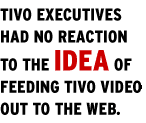| |||||||||

TiVo plus Ethernet not ready for prime time
 Computer hobbyists have succeeded in adding an Ethernet connection to a
TiVo digital video recorder, making it possible to use the consumer device to feed
video-on-demand to the Web. Computer hobbyists have succeeded in adding an Ethernet connection to a
TiVo digital video recorder, making it possible to use the consumer device to feed
video-on-demand to the Web.TiVo uses a hard disk to record cable or satellite TV programs. Unlike most VCRs, TiVo can record a desired program at any time of day by searching an online programming schedule. Andrew Tridgell, one of the lead programmers who volunteered time for the experiment, said he is part of a "core group of about 15 or 20 people who are making modifications" to the device. The group was able to attach a standard Ethernet board, like the ones used to link PCs into a network, to the internal circuitry of TiVo. Once this is done, TiVo can feed a compressed TV program to any PC on the network. From there, it is a small step to create a Web page that would transmit the same program anywhere, although this would require a fast connection. The same thing, of course, could be accomplished by recording TV programs on a standard VCR and then converting the programs to digital form and storing them on a Web server. But TiVo has the advantage of performing these steps automatically. Tridgell, who works as a software developer for Linuxcare, a technical support group in Canberra, Australia, says a professor in his group is considering buying five TiVos. Each unit would record one of the five major TV networks that are available on cable in Australia. Any program that aired in the previous 24 hours could then be viewed later by students.
Naturally, this raises legal questions about copyright. If someone were to
record movies and then charge others to view them, they'd probably be sued
faster than you can say "Napster." However, recording a TV program to view later with a group of friends, free of charge, is almost certainly protected as a "fair use" under various countries' copyright laws. At this point, the idea of adding Ethernet connections to TiVo units is not really ready for prime time. The conversion involves opening the case and inserting custom-made electronics, which is hardly something most home users should attempt. Breaking the seal on the case voids the warranty, according to Rebecca Baer, TiVo's corporate communications manager. TiVo executives had no comment regarding the idea of feeding TiVo video out to the Web. But the promise of an inexpensive, easy way to make automatically recorded TV programs available on the Web is compelling. A commercial add-on product for TiVo users might someday be developed that even novices could handle. The conversion itself is cheap enough. Tridgell says the hardware needed to add networking to a TiVo, including the Ethernet board itself, costs only $10 to $20. Tridgell's modification is not the first time TiVo has been hacked. Analysts reported in June that hobbyists had added a second hard disk to a TiVo, doubling its storage capacity. But Tridgell points out that adding a second hard drive is easy, since TiVo was designed to accommodate two disks. Putting a TiVo on a local area network, by contrast, is far more challenging and makes the device accessible from anywhere in the world. Adding Ethernet connectivity to a TiVo also allows people to save recorded programs to a network's hard disks, giving the unit an unlimited storage capacity. Tridgell's personal goals are simple. When his own experimental unit is fully operational, he just wants to watch programs on his downstairs PC that have been recorded by his upstairs TiVo. His group may have started something, however, that will eventually take video-on-demand out of the home and into cyberspace. Consumer advocate Brian Livingston appears at CNET News.com every Friday. Do you know of a problem affecting consumers? Send info to tips@BrianLivingston.com. He'll send you a book of high-tech secrets free if you're the first to submit a tip he prints. on the soapbox |
|
|||||||||||||||||||||||
|
Send us news tips | Contact Us | Corrections | Privacy Policy |
|

